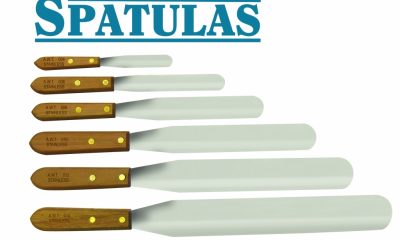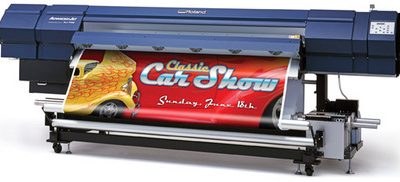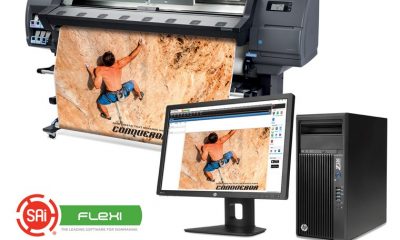Business & Industry
Published
23 years agoon
On close inspection of most screen-printing businesses, one single issue tends to stand out: the amount of training we offer our employees. Some companies offer regular and effective training, but for most of us it seems that all the good intentions in the world don’t necessarily translate into effective training programs. We know we should…could…would, but taking the time to do it right is often easier said than done.
On close inspection of most screen-printing businesses, one single issue tends to stand out: the amount of training we offer our employees. Some companies offer regular and effective training, but for most of us it seems that all the good intentions in the world don’t necessarily translate into effective training programs. We know we should…could…would, but taking the time to do it right is often easier said than done. Some among us actually have a fear of training, distrusting employees who might take their secrets of production success when they leave to work for a competitor across town. This kind of paranoia is usually unfounded. In fact, the most likely reason employees defect to our dreaded competitors is lack of training. The reality is, for growth and progress, we absolutely need employees who have the ability to solve problems. There are few enough candidates in today’s employment marketplace. Developing knowledge and capabilities in the people we already have will help us keep them. There is no better justification for a quality training program. Since the bulk of employees spend their days on the production floor, we will focus our attention there. We don’t exactly have glamorous jobs to offer the working public. Sometimes it’s hot. Sometimes it’s messy. Sometimes it’s a little monotonous. But we can engender loyalty and enthusiasm by offering a path for growth through training. Common training protocol Generally, the novice is "shown the ropes" by a veteran employee. This orientation lasts for one or two days. The new employee gathers just enough information to get started and is then expected to pick up additional skills on the job. The problem with this informal approach is just that: it is informal. Without a doubt, important details will be skipped–details that may cause spoilage or lost time. Even if the new employee is not to blame, this does nothing to improve his or her morale. A good training program can prevent these missed details by offering a checklist of skills a worker must master in a particular job category. This is so important. Take time to think about what skills a production employee should master to be effective on the job. To keep employees motivated further, establish multiple skill levels and prepare checklists for each. Attaining these new levels can mean increased compensation and the opportunity for advancement into positions of greater responsibility–even management. Regardless of the content or form of your training program, there must be a structure to production-floor training. I’ve broken it down into five basic components, starting with the initial training an employee receives on day one of employment. New employee introduction Training for new employees should begin with an overview of the entire process, whether your new employee comes to you with experience or as a total neophyte. I’m sure you’re very busy with your day-to-day duties, but this introduction should come from you as owner or senior manager. Don’t presume that any current employee knows as much about how the process should work as you do. Take the time to walk through the facility with new employees, explaining the process as you go. This attention will leave a permanent and positive impression on each new employee. Starting in order entry, explain what each department does and how it fits into the overall production process. Continue the tour, explaining the process as you go. Cover the art department, screen prep, the inkroom, warehousing, and finally, the production floor. Explain how an order progresses from production to the shipping department and onto the dock. Because of the importance of screen preparation, the screen-prep area is a particular focus of my training program. A good understanding of how screens are prepared is a critical part of training, especially when you expect your printers to attempt their own troubleshooting at the press. Remember, employees who can make good decisions are the most valuable kind. Tools and techniques From squeegees to printing machines, each tool should be explained in detail. Explain what it is, how it is used, and how to maintain it. Include in this explanation a list of common industry terms. You might also offer a printed glossary of terms for new employees. If you are hiring people with no previous screen-printing experience, this is especially important because many production-floor terms are foreign to the general public. The following is a general list of tools and processes I like to discuss with new employees. Squeegees Explain durometer and the common uses for each level of hardness. Offer a basic explanation of the types of squeegees used in your facility, and explain the reasons for each. Screens and mesh Discuss mesh and general uses of the different mesh counts. Also discuss mesh tension and its effects on print quality. The stencil Explain the how’s and why’s of coating, drying, exposure, etc. A good understanding of the screen-preparation process will enable employees to be better troubleshooters. Setup No matter what kind of setup system you use, explain how graphics are lined up on press to achieve the finished multicolor product. Your own brand of time-saving setup techniques should be discussed at this point. This is also a good point to discuss time and efficiency in setup. Techniques This is the area that separates you from the printer down the street. There are dozens of ways to get from point A to point B in screen printing. Here’s where your own style of print technique comes into play. Specifically explain squeegee angle, clearing the screen, off-contact printing, etc. This is your opportunity to discuss wet-on-wet printing, flash curing, and specialty-ink applications, such as high-density (3-D) printing. Hands-on training As with many manufacturing processes, training a screen printer is a hands-on procedure. Employees can hear the explanations and see the machines run, but until they pull a squeegee for the first time, they won’t be able to combine all they’ve learned from the training package. Even in shops that are exclusively automatic, initial training on a manual press will give the new employee a better "feel" for the technology. Begin your training by allowing the trainee to actually print some strike-off squares, then move up to printing some reject garments. At this point, walk away and allow the new printer to get comfortable with the squeegee and the ink without the pressure of someone looking over his or her shoulder. A comfort level with the process will result, and the learning process will become markedly easier. When the new printer is ready, it’s time to buddy up with a veteran on an actual job. Make the new hire responsible for one color of a multicolor design on a manual press or a part of the monitoring process on an automatic. This accomplishes two things. First, the new printer participates in an actual production run. Second, the trainee has the opportunity to watch an experienced printer produce an order. The buddy concept is a tried-and-true training method in this industry. Training materials Training materials are vital to a good training program. Start by providing a vinyl three-ring binder to each new employee. This Employee Technical Guide will become each worker’s production bible as long as he or she remains on your staff. All pertinent paperwork, memos, and instructions will go into the guide, and each guide will be unique to the individual employee. Into this binder will go the glossary of industry terms, worksheets, and notes from training sessions. Divider sheets will be included to break down the worksheets and notes under specific categories: equipment/tools, techniques, troubleshooting, and categories specific to your operation, such as a print location guide, folding and packaging details, etc. If you have a company mission statement, place a laminated copy of it in the front of each book. To save you from replacing pages regularly, use clear page protectors to keep them safe from ink, grease, and soft-drink spills. As training and reference information will differ from job to job, the training binders might be color coded by department . The guides will remain the property of your company and be collected when any employee leaves your employ. Yes, it is true that an employee can copy the guide without your knowledge and take it to his new employer, but this is not likely to do any damage to your company. During each training session, distribute blank worksheets that will go into each employee’s guidebook. Completed handouts that require no participation by the employee are less effective than those that require the use of thought, attention, and a Bic pen. Requiring this note-taking participation also encourages employees to note additional information beyond simply filling in the spaces provided. With each new training subject discussed, offer hands-on examples whenever possible. When you discuss squeegees, have several to pass around the room while you talk. When you discuss the wash-test effects on printed 100% cotton compared to blended fabrics, have samples on hand for employees to touch and examine. The Employee Technical Guide is a fluid document. By revising and improving it, you’ll build an excellent customized manual that is current, up to date, and unique to your own company’s technology and techniques. Ongoing training Training is an ongoing process. Initial training may take a day or two, with training scheduled to continue beyond that. A little time dedicated to production education is all you need to put your company ahead of the game. Fifteen minutes of training once a week goes much further than no training at all, and each session will build upon the last. Most production employees have little opportunity to see the wealth of information that is available only to you through books and magazines. Share technical information or innovations by purchasing additional copies or by passing around marked passages for each employee to read. It isn’t necessary for you to become a full-time instructor. Allow individual employees to give presentations on their own particular skills or to share information learned at outside seminars, training courses, or trade shows. Since many production employees have had little formal education past high school, a classroom-type setting might not be the most conducive to learning. Information needs to be useful and is best received if it is heavy in the hands-on area. Training should come with a little homework as well. Give assignments to try certain production techniques. Have employees report their results either in writing or at your next training session. This accountability should be enough to focus attention, and more importantly, inspire some real learning. You can also take advantage of your distributors as training resources. Most suppliers have someone on staff who would gladly come into your facility for a training session (with their products of course), and frequently there is no charge. It is valuable to see the perspective of someone who not only knows the latest techniques and technologies, but spends time in dozens of other printing facilities. Techniques and technologies can become stale in a company’s closed society. Outside trainers can keep your operation and employees fresh and up to date. Focus on training Training. You know you could…you should…you would. So why don’t you? Make training your priority, and it will naturally become a priority to your staff as well. The results will be better employees, better products, and a better working environment.

Subscribe

Magazine
Get the most important news
and business ideas from Screenprinting Magazine.
Most Popular
-

 Case Studies2 months ago
Case Studies2 months agoHigh-Density Inks Help Specialty Printing Take Center Stage
-

 Art, Ad, or Alchemy2 months ago
Art, Ad, or Alchemy2 months agoF&I Printing Is Everywhere!
-

 Andy MacDougall2 months ago
Andy MacDougall2 months agoFunctional and Industrial Printing is EVERYWHERE!
-

 Columns3 weeks ago
Columns3 weeks ago8 Marketing Mistakes Not to Make When Promoting Your Screen Printing Services Online
-

 Editor's Note2 weeks ago
Editor's Note2 weeks agoLivin’ the High Life
-

 Marshall Atkinson2 weeks ago
Marshall Atkinson2 weeks agoHow to Create a Winning Culture in Your Screen-Printing Business
-

 Thomas Trimingham2 months ago
Thomas Trimingham2 months ago“Magic” Marketing for Screen Printing Shops
-

 News & Trends2 months ago
News & Trends2 months agoWhat Are ZALPHAS and How Can You Serve Them in Your Print Business?






